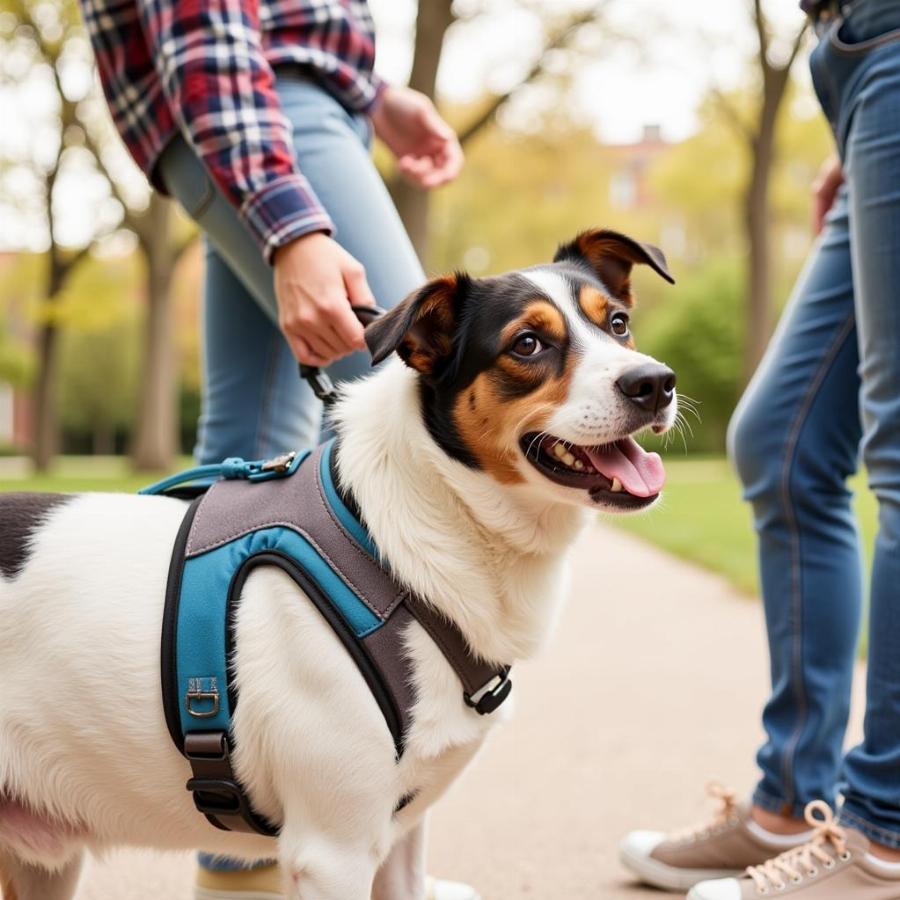Mobility is crucial for a dog’s overall well-being, and back leg weakness can significantly impact their quality of life. If you’ve noticed your furry friend struggling to walk, climb stairs, or even stand comfortably, it’s essential to address the issue promptly. This comprehensive guide explores common causes of back leg support problems in dogs and provides practical tips for providing the best possible care.
Understanding Back Leg Weakness in Dogs
Back leg weakness in dogs can manifest in various ways, from a slight limp to complete immobility. Recognizing the signs early on is vital for effective treatment and management.
Here are some common indicators of back leg weakness:
- Limping or favoring one leg
- Difficulty rising from a lying or sitting position
- Reluctance to jump or climb stairs
- Dragging paws or knuckles touching the ground
- Trembling or shaking in the hind legs
- Yelping or whining when moving
Common Causes of Back Leg Support Issues
A range of factors can contribute to back leg weakness in dogs, from age-related conditions to underlying medical issues.
Some common causes include:
- Arthritis: This degenerative joint disease is prevalent in older dogs, causing pain, inflammation, and stiffness.
- Hip Dysplasia: A genetic condition affecting the hip joint, leading to instability and discomfort.
- Cruciate Ligament Injuries: Similar to ACL tears in humans, these injuries affect the knee joint and can cause lameness.
- Degenerative Myelopathy: A progressive neurological disorder that affects the spinal cord, leading to weakness and coordination problems.
- Intervertebral Disc Disease (IVDD): A condition where the discs cushioning the vertebrae rupture or bulge, pressing on the spinal cord and causing pain and weakness.
- Injury or Trauma: Accidents, falls, or strenuous activity can lead to sprains, strains, or fractures affecting the back legs.
Seeking Veterinary Care: Diagnosis and Treatment
If your dog exhibits any signs of back leg weakness, it’s crucial to consult a veterinarian for a proper diagnosis. The vet will conduct a thorough physical examination, review your dog’s medical history, and may recommend additional tests, such as:
- X-rays: To assess the bones and joints for arthritis, dysplasia, or fractures.
- Blood tests: To rule out underlying medical conditions.
- Neurological examination: To evaluate nerve function and identify potential neurological disorders.
Treatment for back leg weakness in dogs depends on the underlying cause and severity of the condition. Options may include:
- Medications: To manage pain, reduce inflammation, or address underlying medical conditions.
- Surgery: In cases of severe hip dysplasia, cruciate ligament tears, or certain spinal cord issues.
- Physical Therapy: To improve mobility, strengthen muscles, and reduce pain.
- Supportive Care: Providing a comfortable bed, ramps, and assistance with mobility.
Providing Support at Home: Tips for Dog Owners
While professional veterinary care is essential, you can do many things at home to support your dog’s back leg health and make them more comfortable:
- Weight Management: Maintaining a healthy weight is crucial for reducing stress on joints, especially for dogs with arthritis or hip dysplasia.
- Controlled Exercise: Engage your dog in regular, low-impact exercises like swimming or short walks on soft surfaces to maintain muscle mass without overexertion.
- Joint Supplements: Consider adding joint supplements containing glucosamine, chondroitin, and omega-3 fatty acids to your dog’s diet to support joint health.
- Assistive Devices: Ramps, harnesses, and slings can assist dogs with mobility issues, making it easier for them to navigate stairs, get in and out of vehicles, or go for walks.
- Comfortable Bedding: Provide your dog with a soft, supportive bed, ideally orthopedic, to cushion joints and promote restful sleep.
 Dog using assistive harness for back leg support
Dog using assistive harness for back leg support
FAQs: Back Leg Support for Dogs
Q: How can I tell if my dog’s back leg weakness is serious?
A: Any sudden limping or difficulty walking warrants a vet visit. Look for additional signs like yelping, paw dragging, or reluctance to stand.
Q: Can back leg weakness in dogs be cured?
A: The prognosis depends on the underlying cause. While some conditions are manageable, others may require long-term care. Early intervention often yields the best outcomes.
Q: Are there any home remedies for back leg weakness in dogs?
A: While home care is helpful, always consult your vet before starting any new treatments. They can recommend safe and effective options for your dog’s specific needs.
Seeking More Guidance?
Beaut Dogs is your go-to resource for all things dog-related, offering reliable and insightful information on the wonderful world of canines. We’re here to support your journey in providing the best possible care for your furry companion.
For personalized advice on back leg support for your dog, don’t hesitate to reach out to us. Email: [email protected] for detailed and accurate answers. Beaut Dogs – Your trusted partner in canine care.